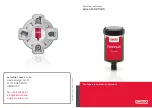
PAGE 1-14
CHAPTER 2 MAINTENANCE
NMC-WOLLARD
2021 Truax Blvd. Eau Claire, WI 54703 ● P: 715-835-3151● F: 715-835-6625 ● www.nmc-wollard.com
TML-704H Maintenance Lift Manual No. 310547
1 SERVICING
SEPTEMBER 01, 2015
• Keep all hoses and connections in good serviceable condition. Check before
start-up and periodically during operation.
• Do not investigate for leaks with hands. Use a large piece of cardboard
1.8.2 Special Instructions
The hydraulic oil is supplied to the hydraulic system from a reservoir installed
in the chassis next to the left front fender behind the operator’s seat. The
reservoir has a sight gauge attached for determining the level of oil. See 1.3
for lube specification and capacity.
NOTICE!
Always check hydraulic oil level with the platform lowered to within 1
ft. of full down and stabilizers fully retracted. Failure to follow these
instructions could cause overfilling.
NOTICE!
Dirt or contamination is the greatest enemy of any type of
hydraulics! Cleanliness is the best way to insure satisfactory component life,
on either new or repaired units. Cleaning parts by using a solvent wash and
air drying is adequate if clean solvent is used. This is precision equipment.
The internal mechanism and related items must be kept free of foreign
materials and chemicals
• Cleanliness is the best way to insure satisfactory component life, on either
new or repaired units. Cleaning parts by using a solvent wash and air
drying is adequate if clean solvent is used. This is precision equipment.
The internal mechanism and related items must be kept free of foreign
materials and chemicals.
• Protect all exposed sealing surfaces and open cavities from damage and
foreign materials.
• Always replace gaskets and O-rings. Clean gasket sealing surfaces prior
to installing new gasket. Lightly lubricate all O-rings with clean petroleum
jelly prior to assembly.
• Keep oil storage areas clean and dry.
• Keep barrel bungs covered and sealed until you’re ready to use the oil.
Clean the bung seals before removing them, and clean the bung before
removing it.
•
Use only clean pumps and conduits to transfer fluid from barrels to the
reservoir. Clean the system’s entry port thoroughly.
•
Filter all fluid introduced into the reservoir through a nominal,
no-bypass,10-micron filter. Do not use a bucket or such method.
•
Never add used fluid to the system. The high costs of downtime and
component replacement is more costly than the price of new oil.
•
Never mix hydraulic fluids. It is highly possible that the additive package of
one fluid will not be compatible with the other’s additives. You can end up
with a fluid in which none of the additive packages do their jobs.
• In the event of a catastrophic failure of a pump or motor: Drain, clean,
flush the system, and change filters. Otherwise, metal particles and
dirt can remain in the system to cause damage after you replace the
component.
Property of American Airlines
















































